Today, we met up with the Stentz-Buecher family at their winery in Alsace to learn all about the work and skill to make and age their organic wines. It’s a family business as Céline explained to us, and she manages it with her brother, Stéphane. They have both taken different paths to become wine-makers, and are complimentary in their work and their way of seeing wine. They were with us to explain all of the work in the cellar to produce the best possible wines they can from when the grapes are picked right through to bottling.
We started the day in the vineyard, because that is where everything begins, and we visited one of the 74 plots that make up the winery’s 12 hectares of vines. It’s necessary to have lots of plots to be able to express the diversity of the 7 grape varietals used to make Alsace wines. Pinot Noir for the reds, Pinot Blanc, Pinot Gris, Sylvaner, Muscat, Riesling and Gewurztraminer for the whites, all planted in different types of soil on the hillside and the plain.
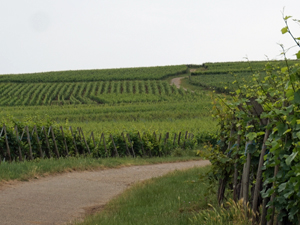
In the Rosenberg vineyard, where our Pinot Gris adopted vines are planted, we saw that the branches have been placed between the training wires, and that the flowering period has just finished. We could see the little grains that will become grapes. To Céline it looks like they have grown since the day before! It’s possible, because with the heat and rain at the moment, the vines can grow 2cm a day. We took a few moments to take some pictures with our vines, because for the 2020 vintage, this is the last time that we’ll be coming.
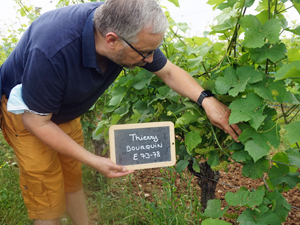
On the way back, we looked at the different plots, their location, their exposition to the sun, and the different soil types. All important features that will help give the wines their taste and aromas.
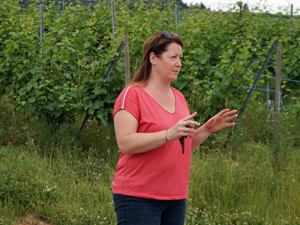
Before getting down to the practical sessions, we talked about wine-tasting. It’s all about perception, and is a unique and personal experience for all of us. We use all of our senses when tasting, and once stimulated, they send lots of information to our brain, who has the task of filtering and treating them. For example, our ears enable us to analyse the bubbles in a crémant. Our eyes tell us information about the colour of a wine, its intensity and tint, its viscosity, shine, and clarity. Our nose adds information about the aromas, and our mouth for the taste and texture. Each person perceives this information differently, and the good news is that we can all train ourselves to improve.
We then talked in more detail about aromas and where they come from. Are they primary aromas that come from the terroir or grapes themselves, secondary aromas that result from the fermentation phase, or tertiary and due to the choices made during the ageing process? To help us better understand the differences, Céline had prepared a little game to blind taste different wines, in a blacked-out glass and with covers over the bottles, so that we had just our nose and mouth to rely on.
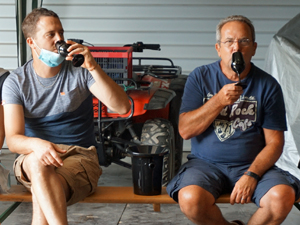
We tasted the wines by two in order to try and identify the difference between them and why. For example, we first tasted a Pinot Blanc Tradition with white peach aromas, and which was well balanced and fresh on the palate. We then tasted a wine that was completely different, its golden yellow colour being more unusual, and revealing smoky and toasted aromas. It was dry and full bodied on the palate. In fact it was also a Pinot Blanc, but made from a plot of old vines and aged in barrels on its fine lees, which changes the primary and tertiary aromas. We continued our comparisons, tasting 6 wines in total.
Now that we were experts in the art of wine-tasting, we headed down into the cellar to catch up with our Pinot Gris wine from where we had left it during the harvest time. Stéphane reminded us of the relationship between alcoholic maturity, phenolic maturity, and the aromatic potential of wine. The higher the degree of alcohol, the better the potential for keeping wine, but that counts for nothing if there aren’t expressive aromas, something that is linked to the phenolic maturity, which is achieved around a month after the alcoholic maturity. The difficulty lies in waiting to have sufficient phenolic maturity without the alcoholic degree rising too much, which is why when it’s too hot and the alcoholic degree is reached prematurely in August, it doesn’t bode well for a good phenolic maturity.
Stéphane then explained the fermentation and vinification processes of the white and red wines, and then we headed to the part of the cellar where the wines ferment in the casks. Some of the wines are still in the process of fermenting, because the winery only uses indigenous yeast, and lets the wines work at their own pace. We could still hear some of the vats and casks gurgling away as the carbon dioxide escaped through the siphons.
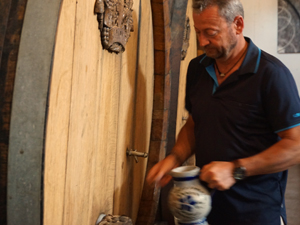
The other wines such as the Pinot Gris Rosenberg had finished fermenting, and we had the chance to taste it directly from the cask. It will soften a bit more over the summer, before being ready for Stéphane to filter and bottle.
We finished the morning in the barrel room to see where the red and some of the vielle vignes white wines are aged. We asked lots of questions about the role of oak barrels, the difference between old and new ones, and the varying sizes etc. We had a very enthusiastic group and some great interactions.
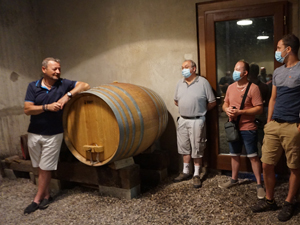
It was then time to head up and outside for an aperitif, starting with a naturally sparkling crémant, made using the Champagne method, but without the liqueur being added, accompanied by a savoury Kouglof. We then sat down to a delicious choucroute, cheese platter, and black forest gateau, all accompanied with delicious wines of course!
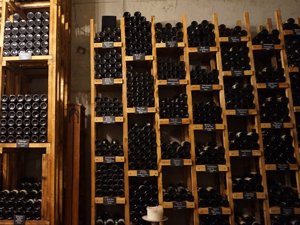
After lunch we returned to the cool of the cellar to see the wine library where the old vintages are stored. It’s also a reception room for tastings and family meals. Only the most promising vintages are stocked, and each year, Stéphane and Céline uncork several dozen bottles, taste them, and re-cork them to ensure that they are still good. The oldest wine from the winery dates back to 1969.
The day ended with the bottling and labelling machine, where the wine is held in a vat before passing through a filter on its way to being bottled and corked. The bottles are then labelled and boxed up at the end of the line. The wine is then ready to join the cellars and glasses of organic Alsace wine enthusiasts around the world. We can’t wait to taste the 2020 vintage of our Pinot Gris Rosenberg!
Comments
No comments.




